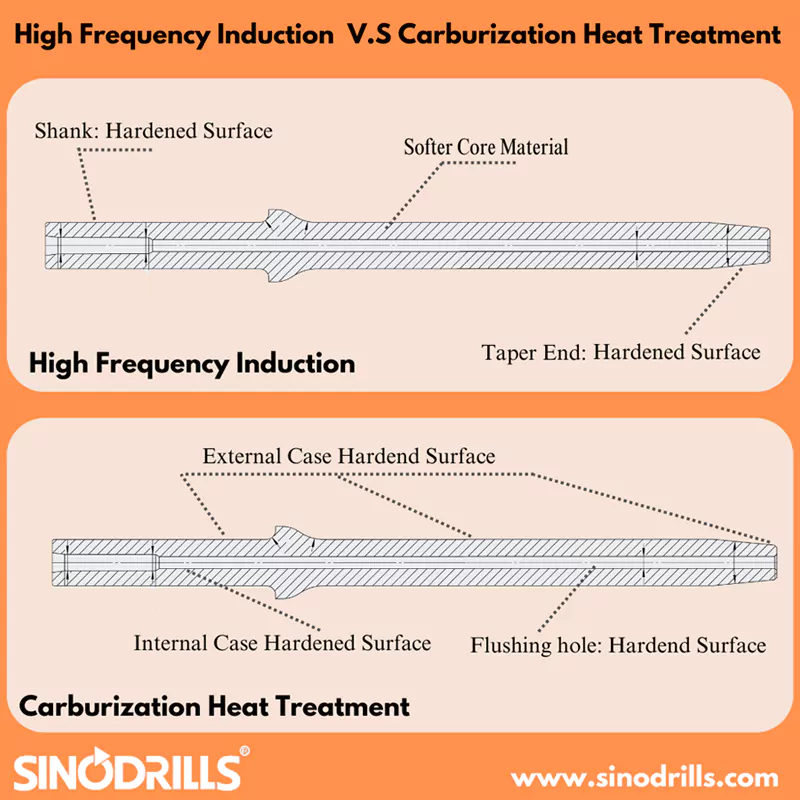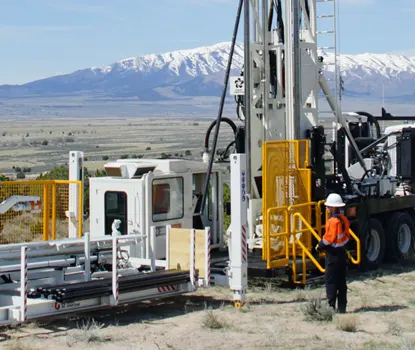Tapered drill rods are driven by small pneumatic or hydraulic rock drills, in conjunction with tapered drill bits, to perform shallow drilling operations. They are commonly used in industries such as mining, tunneling, quarrying, and construction.
The heat treatment methods for tapered drill rods include high-frequency induction and carburization heat treatment.

1. High-Frequency Induction
High-frequency induction is a method to heat and cool the surface of raw material by high-frequency current to obtain a surface-hardened layer. This method only strengthens the surface to a certain depth, while the core largely retains its pre-treatment structure and properties. The heating process in high-frequency induction typically takes only a few seconds to complete, thus significantly reducing quenching deformation and lowering energy consumption. High-frequency induction is suitable for various structural steels.
The process is to preheat the raw material first, then heat the surface of the raw material with high-frequency current to the quenching temperature, followed by rapid cooling to form a surface-hardened layer. Then annealing is performed to eliminate quenching stress and maintain the overall performance of the raw material. Finally, tempering further adjusts the hardness and improves the toughness of raw materials.
In general, only the shank and tapered end of the tapered drill rod undergo high-frequency induction, increasing the strength of both ends, while the body of the tapered drill rod remains its original toughness. This type of tapered drill rod is more flexible and suitable for softer geology and surface as well as loose rock layers. Under certain conditions, high-frequency induction hardened tapered drill rods are more economical.
2. Carburization Heat Treatment
Carburized taper drill rod is usually made of low-carbon alloy steel (with carbon content less than 0.25%). This process mainly increases the carbon content of the surface and core hole surface of the tapered drill rods’ body through chemical heat treatment, creating a carbon concentration gradient from the surface inward of a certain thickness. By quenching and tempering, the surface layer of the tapered drill rods achieves high hardness and wear resistance, while the center part retains the toughness and plasticity of low-carbon steel.
The process of carburization is to put the raw material into a carburizing furnace, heat it to about 900-920°C, and maintain it for sufficient time, allowing the active carbon atoms decomposed from the carburizing medium to penetrate the surface layer of the raw material.
Carburized tapered drill rods receive a case hardness layer externally and internally (flushing hole), providing rigidity and surface resilience to the entire tapered drill rod. This type of tapered drill rod has a stronger resistance to bending and can transmit higher torque and stress loads in demanding conditions. The carburization process also extends fatigue life and provides corrosion resistance, making the carburized tapered drill rod suitable for various complex geological conditions, especially in underground or tunnel drilling.
Overall, high-frequency induction-hardened tapered drill rods are more economical and can be chosen for drilling in softer or looser rock layers. If the geological conditions are complex and require high hardness and wear resistance in the tapered drill rods, then carburized tapered drill rods can achieve much better performance.



